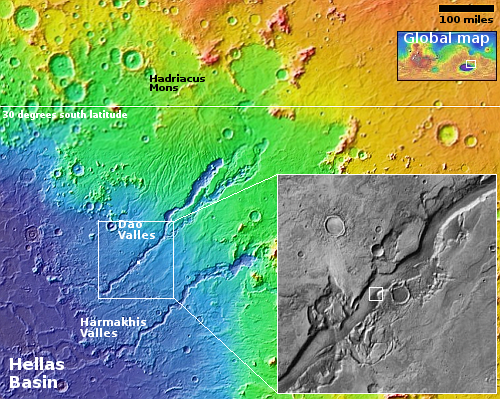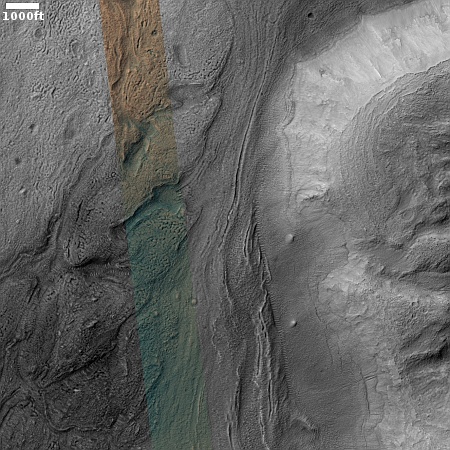A Martian river of ice
Cool image time! The picture to the right, cropped, reduced, and sharpened to post here, was taken on January 26, 2025 by the high resolution camera on Mars Reconnaissance Orbiter (MRO). The science team labeled it “Looking for Gullies” because the researchers were likely searching for such geological features on the cliff wall that runs down the right side of the picture.
What is more significant however about this picture is the glacier features in the canyon below that cliff. The downhill grade is to the southwest, and it is very evident that the canyon is filled with glacial-type debris, flowing down that grade. Along the base of the cliff the flow seems focused but squeezed, the larger blocks to the west moving slower and thus acting like a wall themselves. In between the flow moves like rapids in a narrow part of a river, albeit in slow motion.

The white dot on the overview map to the right marks the location, inside the 750-mile-long Dao Vallis canyon that descends into Helles Basin, the death valley of Mars. As I noted in 2021, Dao Vallis is one of several similar long glacier-filled canyons on Mars that strongly suggest that slowly flowing ice formed many of the red planet’s many meandering canyons, not flowing water.
Though there is evidence that the initial formation of this canyon was related to volcanic activity at its source, the Dao Vallis we see today was shaped neither by a river of lava nor a river of water. Instead, what we see is a river of ice, its channel incised over eons by the slow downward flow of glacier that presently fills it.
There are no glaciers as long as this on Earth, and thus Dao Vallis offers us a look at a geological process that while superficially resembling glaciers on Earth, is still significantly alien. And though alien to us it might actually be common on Mars, and a fundamental component of its geological history.
It remains unproven whether ice or water formed Mars’ many meandering river-like channels. Liquid water fits our Earthbound expectations, so that is what most scientists favor. On Mars however no climate model can convincingly create an atmosphere in the far past that was warm and thick enough to allow liquid water to flow.
Thus, a river of ice like Dao Vallis puts forth that other more alien possibility, that ice created these channels, and that we need to step away from our Earthbound expectations and look at different processes more appropriate for Mars to explain its geology.
On Christmas Eve 1968 three Americans became the first humans to visit another world. What they did to celebrate was unexpected and profound, and will be remembered throughout all human history. Genesis: the Story of Apollo 8, Robert Zimmerman's classic history of humanity's first journey to another world, tells that story, and it is now available as both an ebook and an audiobook, both with a foreword by Valerie Anders and a new introduction by Robert Zimmerman.
The print edition can be purchased at Amazon or from any other book seller. If you want an autographed copy the price is $60 for the hardback and $45 for the paperback, plus $8 shipping for each. Go here for purchasing details. The ebook is available everywhere for $5.99 (before discount) at amazon, or direct from my ebook publisher, ebookit. If you buy it from ebookit you don't support the big tech companies and the author gets a bigger cut much sooner.
The audiobook is also available at all these vendors, and is also free with a 30-day trial membership to Audible.
"Not simply about one mission, [Genesis] is also the history of America's quest for the moon... Zimmerman has done a masterful job of tying disparate events together into a solid account of one of America's greatest human triumphs."--San Antonio Express-News
Cool image time! The picture to the right, cropped, reduced, and sharpened to post here, was taken on January 26, 2025 by the high resolution camera on Mars Reconnaissance Orbiter (MRO). The science team labeled it “Looking for Gullies” because the researchers were likely searching for such geological features on the cliff wall that runs down the right side of the picture.
What is more significant however about this picture is the glacier features in the canyon below that cliff. The downhill grade is to the southwest, and it is very evident that the canyon is filled with glacial-type debris, flowing down that grade. Along the base of the cliff the flow seems focused but squeezed, the larger blocks to the west moving slower and thus acting like a wall themselves. In between the flow moves like rapids in a narrow part of a river, albeit in slow motion.

The white dot on the overview map to the right marks the location, inside the 750-mile-long Dao Vallis canyon that descends into Helles Basin, the death valley of Mars. As I noted in 2021, Dao Vallis is one of several similar long glacier-filled canyons on Mars that strongly suggest that slowly flowing ice formed many of the red planet’s many meandering canyons, not flowing water.
Though there is evidence that the initial formation of this canyon was related to volcanic activity at its source, the Dao Vallis we see today was shaped neither by a river of lava nor a river of water. Instead, what we see is a river of ice, its channel incised over eons by the slow downward flow of glacier that presently fills it.
There are no glaciers as long as this on Earth, and thus Dao Vallis offers us a look at a geological process that while superficially resembling glaciers on Earth, is still significantly alien. And though alien to us it might actually be common on Mars, and a fundamental component of its geological history.
It remains unproven whether ice or water formed Mars’ many meandering river-like channels. Liquid water fits our Earthbound expectations, so that is what most scientists favor. On Mars however no climate model can convincingly create an atmosphere in the far past that was warm and thick enough to allow liquid water to flow.
Thus, a river of ice like Dao Vallis puts forth that other more alien possibility, that ice created these channels, and that we need to step away from our Earthbound expectations and look at different processes more appropriate for Mars to explain its geology.
On Christmas Eve 1968 three Americans became the first humans to visit another world. What they did to celebrate was unexpected and profound, and will be remembered throughout all human history. Genesis: the Story of Apollo 8, Robert Zimmerman's classic history of humanity's first journey to another world, tells that story, and it is now available as both an ebook and an audiobook, both with a foreword by Valerie Anders and a new introduction by Robert Zimmerman.
The print edition can be purchased at Amazon or from any other book seller. If you want an autographed copy the price is $60 for the hardback and $45 for the paperback, plus $8 shipping for each. Go here for purchasing details. The ebook is available everywhere for $5.99 (before discount) at amazon, or direct from my ebook publisher, ebookit. If you buy it from ebookit you don't support the big tech companies and the author gets a bigger cut much sooner.
The audiobook is also available at all these vendors, and is also free with a 30-day trial membership to Audible.
"Not simply about one mission, [Genesis] is also the history of America's quest for the moon... Zimmerman has done a masterful job of tying disparate events together into a solid account of one of America's greatest human triumphs."--San Antonio Express-News


